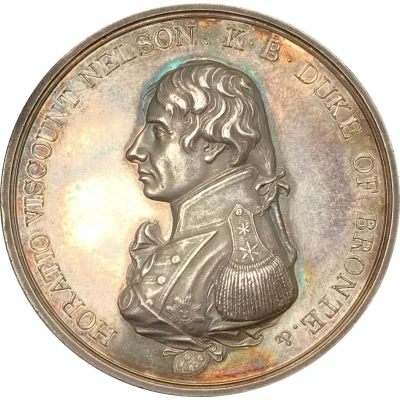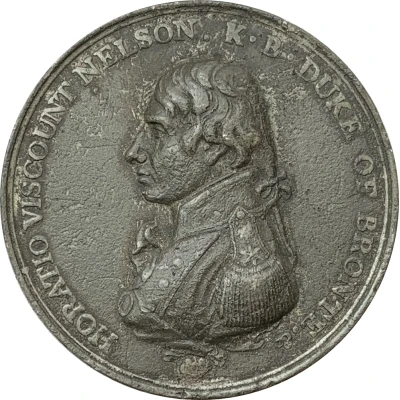


© apuking (CC BY-SA)
Medal - Admiral Nelson, Boulton’s Trafalgar Medal
1805 year| Silver | 50.80 g | 48 mm |
| Location | United Kingdom (United Kingdom, British Overseas Territories and Crown Dependencies) |
|---|---|
| King | George III (1760-1820) |
| Type | Commemorative medals › Military medals |
| Year | 1805 |
| Composition | Silver |
| Weight | 50.80 g |
| Diameter | 48 mm |
| Shape | Round |
| Technique | Milled |
| Orientation | Medal alignment ↑↑ |
| Updated | 2024-11-14 |
| Numista | N#262376 |
|---|---|
| Rarity index | 97% |
Reverse
View of the Battle of Trafalgar with an inscription on a ribbon above.
Script: Latin
Lettering:
ENGLAND EXPECTS EVERY MAN WILL DO HIS DUTY
TRAFALGAR OCT. 21 . 1805.
Engraver: Conrad Heinrich Küchler
Edge
Plain
Comment
Milford Haven 1919# 496After dogging the enemy fleet for some time Nelson eventually brought the combined French and Spanish fleet - a total of thirty-three ships - to battle off Cape Trafalgar on the 21 October 1805. Attacking in two columns, the port under Nelson and the starboard led by Admiral Collingwood, the battle lasted some seven hours. Seventeen enemy ships were captured, one was burnt and the remainder fled. Nelson died as a result of a musket ball wound received early in the engagement. His body was brought back to England and he was buried in the crypt of St Paul's Cathedral on 9th January 1806.
This medal was produced at Matthew Boulton's own expense and was given to the seamen and marines who took part in the action as well as to the families of the deceased in action of the battle.
Boulton was "publicly saddened" that King George III had not produced an award for the brave Royal Navy seamen who fought & won the Battle of Trafalgar on 21st October 1805.
However, the situation on the ground (and in the harbours) at the time of the delivery & presentation of the medals, which were all originally housed in small, flat, two piece metal shells, could only be described as a scene of total ingratitude. When the crews found out that the medal where not made of silver and couldn't be 'popped' (Pawned) for 5 shillings for tobacco money the vast majority were duly thrown overboard into the harbour.
The intention was for copper specimens only and Boulton notes in an undated holograph that some 14,001 specimens were distributed. In a letter to Miss Fanny De Luc dated 20th October 1806 Boulton states that he is "preparing nineteen thousand as presents from me to the Heroes of Trafalgar"; whether the former or the latter figure is correct is unknown. The strikings in other metals were probably made at about the same date but were not intended for the survivors of the battle. Graham Pollard notes in his article on Matthew Boulton and Küchler in the 'Numismatic Chronicle' for 1970, (pp. 303-9, No. 30) that together with the letter to Miss De Luc referred to above, a few examples of his medal were sent for presentation at Court. These were struck in silver gilt, bronzed and Grain Tin. There being some disappointment among those ladies who did not receive them, a further parcel containing six gilt, six bronzed and six white metal was sent on 21st January 1807.
Some strikings in silver and copper exist without the edge inscription and the National Maritime Museum has a trial striking in white metal (see S.Pa/15). This museum also has examples in gold, as does the British Museum. One of those in the National Maritime Museum has an edge inscription in engraved capitals reading IN TESTIMONY OF MERIT . TRAFALGAR . OCT XXI. 1805.
There is a variety of the medal (see Brown 1 p144.584A) which exhibits an earlier, unapproved portrait of Nelson, the main differences being in the somewhat curlier hair and the lapel of the uniform which is folded back: see M.H. 494. The Birmingham Museum and Art Gallery has a hot tin trial of a somewhat earlier version of the unfinished obverse die, this is from the Philip collection (See Brown 1 p144.584B).
In 1966 restrikes from the original dies for this medal were made by John Pinches Ltd. These were advertised as being in hallmarked 22ct. gold (100 specimens) price £96.7.3d. inland, £82 overseas and Hallmarked sterling silver (2,500 specimens) price £8.10.6d., inland, £7.10.0d. overseas. The dies of these restrikes were used when rusty, particularly the reverse and these marks may be noticed around the word OCTR.
The British Museum has a trial piece (registration no. M.5262) in tin which uses a somewhat similar obverse die whilst the reverse has a seated female with a child in her lap; there are two shields beside her on the ground. The artists' guide lines are visible on both obverse and reverse and the planchet shows signs of being previously used for the Küchler's Suvarow medal.
This medal was restruck after the death of Küchler. See Pollard, Matthew Boulton and Conrad Heinrich Küchler, 'Numismatic Chronicle', 1970, pp. 314-16.



